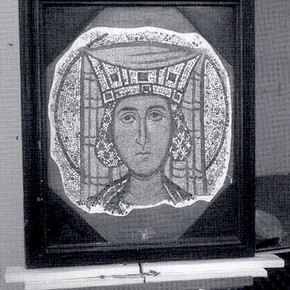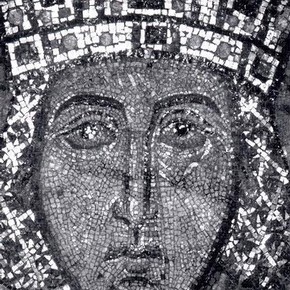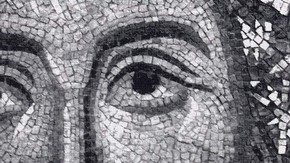Conservation Journal
April 1994 Issue 11
A saint unveiled
In 1857 the founder of the V&A's Italian collection, John Charles Robinson, acquired part of a wall mosaic depicting a colossal head. He believed it to have originated from Ravenna and dated it around the 8-9th century. For over a hundred years the mosaic was known only as the colossal head until, recently, research by art historian I. Andrescu-Treadgold revealed a rather intriguing story of deception.

Fig. 1 The Mosaic displayed in the Victorian print frame. Photography V&A Photographic Studio (click image for larger version)
At the time of J.C. Robinson's acquisition, a mosaic restorer, Giovanni Moro, was running the Baptistery workshop of St Mark's in Venice. He was the head restorer for mosaics in this particular church. As was common practice at the time, Moro would restore badly damaged mosaics by removing large sections and replacing with new. Moro would keep the removed sections of mosaics in his studio. Usually they would be cannibalised - odd pieces of tesserae could be used to restore less damaged mosaics or indeed to make up completely new sections - but not uncommonly they would be sold. It has been alleged that, having been requested to remove, restore and prepare a mosaic for shipping, Moro made a complete replica from new tesserae1 . This is not the only offence of which Moro has been accused. It was not unheard of at the time for art dealers to facilitate the exportation of national works of art by giving misleading information. The uncertain origin of the V&A's colossal head can be well understood given the facts above.
The V&A's mosaic is now believed to be closely related to the baptistery workshops of St Mark's in Venice2 and from the same source it is believed that the figure is that of St Catherine of Alexandria. It was due to I. Andrescu-Treadgold wanting to photograph the mosaic for a future publication, no doubt revealing how she came to conclude these facts, that the mosaic was brought into the V&A sculpture conservation studio.
One of the most interesting aspects of the mosaic is how the fragment has been mounted and exhibited. It is quite noticeable that the head of St Catherine is a fragment of a much larger mosaic. In typical Victorian style it has been displayed as a portrait3 . Set into an octagonal casing the fragment naturally had tesserae coming loose and lime plaster crumbling around its edges. This was simply solved by applying a coat of plaster of Paris which followed the contours of the halo around the nimbus and was painted with a metallic gold paint. The octagonal frame was then placed into a portrait frame with diagonal corner settings. Discussions regarding the actual framing and presentation of the mosaic were held sporadically throughout its sojourn in the sculpture conservation studio. There had been questions asked about the ethical correctness of portraying a 14th century mosaic in a 19th century frame especially as the frame was of a style typical to portraiture. A decision was made by the curator (Paul Williamson) to paint the plaster of Paris surround along with the diagonal corner settings of the frame in a similar, uniform colour which would then give the impression of the mosaic being set in a rectangular frame.
Before describing the conservation carried out on St Catherine, it is perhaps as well to describe briefly the materials and techniques used to execute such a mosaic. The green, yellow, red and black tesserae are made of glass. The gold tesserae were made by hermetically sealing gold leaf between sheets of glass4 . The flesh coloured and dark brown tesserae are made of limestone and the white tesserae of the nimbus are believed to be alabaster. The tesserae are set into a lime plaster, the base of the plaster having a large aggregate mix graduating to pure lime on the surface.
The procedure by which a wall mosaic was executed was similar to that used in floor mosaics. A cartoon of the total design was sketched onto the penultimate layer of plaster. If the design was a figure, the master craftsman would start work on the head leaving the background to his assistants. He would lay the final layer of plaster over a small portion of the cartoon and begin inserting the Tessa Rae; this was to ensure that the plaster would not dry out before he had applied enough tesserae.
As in floor mosaics, three different methods could be used; the direct, the indirect and the reverse methods.
1. Direct - the tesserae are individually set into the bedding mortar.
2. Indirect - the tesserae are first bedded in sand and then strong paper or cloth is glued to their upper surface. Once the glue has set, the design can be removed from the sand and eventually reset onto bedding mortar (use for transporting). When the bedding mortar has dried the glue is then dissolved with hot water.
3. The reverse method is similar to the indirect method, but instead of the surface of the tesserae being laid face up, each piece is glued face down onto a coloured paper or cloth cartoon. After the section has been finally relayed and the cartoon washed off, the resulting picture is the reverse of that which was shown in the workshop5 .
The uneven surface of the tesserae in the mosaic of St Catherine led to the conclusion that it had been made in situ. Apart from the decades of dirt that had settled on the surface and the crumbling plaster of Paris on the edges, the main cause of concern was a number of cracks running horizontally across the mosaic. Some of the Tessa Rae close to the cracks had become loose and others had already fallen out and were lost. Initially it was believed that the cracks had occurred due to rusty iron dowels set in the lime mortar beneath the tesserae. X-rays proved that this was not the case. However they did reveal a number of iron nails set beneath the plaster of Paris, along with some hidden gold tesserae. As a result of the information obtained from the X-rays, it was decided to:
1. reveal all the hidden tesserae by cutting back the edges of the plaster of Paris.
2. leave the nails that ran horizontally through the wood octagonal frame into the mortar and obviously held the mosaic fragment securely in the octagonal frame.
3. remove four large redundant nails that ran through the surface of the mosaic to the mortar and had rusted.
The mystery of the cracks was finally resolved by I. Andrescu-Treadgold who pointed out that similar cracks could be found on other mosaics that had been removed from niches. The flattening out of a once curved surface naturally results in a number of cracks.
A preliminary clean was carried out using vacuum and paintbrush. This had very little effect on the appearance of the mosaic, the dirt being well ingrained. A cleaning test was carried out on all the tesserae. The grouting, coloured glass and gilded glass tesserae were found to clean best with a 100 ml mixture of deionised water and white spirit (1:1) and 5 ml Synperonic N. The alabaster tesserae had an unusual problem which only became apparent when viewed under a microscopic lens. They had produced a fine crust on their surface. It is not known what caused this crust but it had formed with the dirt and was harder than the material beneath it. Water was held on its surface but was readily absorbed beneath it. Having tested numerous solvents and gels it was decided to use a more traditional method of cleaning mosaics but with modern materials - Solvol Autosol. Mosaics are usually cleaned by gently rotating a damp brush with pumice powder, however, because of alabaster's sensitivity to water, Solvol can be used in a more controlled manner and removed with white spirit.
Once the mosaic had been cleaned completely, the plaster of Paris edges were
cut back not only to tidy up the crumbling edges but also to uncover the hidden tesserae that the X-ray had revealed. The rusty nails were also uncovered beneath the plaster of Paris and were drawn out slowly with the aid of clamps. The holes were sealed with Paraloid B72 in toluene and filled with Fine Surface Polyfilla. With the agreement of the curator (Paul Williamson) the missing tesserae on the face of St Catherine were filled in with the use of Polyfilla and acrylic paints.
It was at this stage that the photographs were taken for I. Andrescu-Treadgold's forthcoming publication. Although the mosaic had originally come from one of the store rooms solely for the purpose of being photographed it is now to be exhibited.
References
1. Andrescu-Treadgold, I. The Wall Mosaics of San Michele in Africisco, Ravenna Rediscovered, Paper from conference held at the Universita Degli Studi Di Bologna Instituto Di Artictita Ravernati E Bazantine, 30 March - 4 April1990, p. 23.
2. (as above), p.39.
3. Other examples of the same period can be seen in the above book.
4. Gold leaf would be gilded onto a glass disc using gum water. The glass would then be placed on an iron plate, into a furnace with a glass covering until red hot then pulled out and cooled.
5. See Sear, F. & Neal, D.'s article in Strong, D. & Brown, D. Roman Crafts, Duckworth, London, 1976.
Materials reference
Acrylic paints: George Rowney Ltd. London. Deionised water: Purite Ltd., Thames, Oxfordshire.
Paraloid B72: Conservation Resources UK Ltd., Cowley, Oxford.
Polyfilla: Contains mainly plaster of Paris with some retarders and plasticizers. Available from builder's merchants and hardware stores.
Solvol Autosol: Contains mainly Kieselguhr, potassium oleate - a methylated soap and white spirit. Available from automobile repair shops.
Synperonic N: Non ionic detergent. Toluene: BDH Chemicals Ltd, Poole.
White Spirit: Available from builder's merchants and hardware stores.
April 1994 Issue 11
- Editorial
- A saint unveiled
- 17th Century Chinese canopied bed
- Recording the changes: V&A conservation departmental archive
- The ageing & stabilisation of shellac varnish resin - an undergraduate research project at Imperial College
- Treatment of an early 18th Century Indian chintz qanat
- ICCROM - Japanese paper conservation course 1993: an introduction to the ancient skills of scroll mounting for the modern conservator
- Sand cast aluminium

